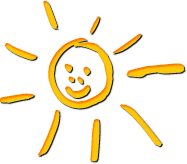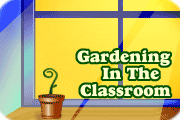|
Volume 6, Issue 8
April 14, 2008
A WORD ABOUT THIS ISSUE'S THEME
Celebrate gardens by inviting your young children to repeat the words and perform
the actions in our "Garden Rap."
 Get a trowel Get a trowel
And a rake.
Dig the dirt,
Now jump and shake!
Make some rows
Long and neat.
Plant some seeds
Now stamp your feet!
Water well
All those rows.
Now stretch up high
On your toes!
See the plants
Green and new.
Now clap your hands
Hooray for you!
Susan LaBella
Editor, Early Childhood Education Newsletter
Free sun clipart from Designed to a T
ACTIVITY IDEAS
 GROWING FLOWERS GROWING FLOWERS
Tell your students that they are going to pretend to be seeds. Turn off the lights and have children crouch down. Play a recording of rain falling. Tell your children they should grow a little when it rains. Children can now stand about half way up. Turn on the lights [to represent the sun coming out]. Tell children the sun has helped them push through the dirt and above the ground. Children stand a bit more. Finally play music and tell children they will continue growing until they are fully grown. Children should stand tall.
SEEDS, SEEDS, SEEDS
Talk with children about seeds. Gather seeds of as many kinds and sizes as you can. (Don't forget a peach pit.) Then
--- invite children to sort the seeds smallest to largest.
--- describe one of the seeds and let children try to identify the one you are describing.
--- let children glue seeds onto construction paper to create interesting designs.
After these activities, read aloud to children The Tiny Seed by Eric Carle. Provide time after reading for children to retell parts of the story. Finally, let children make their own seeds: Trace the footprint of each child, then have children stand their footprint-seeds in a vertical position and add eyes, a small nose, and a smiling mouth.
I CAN READ!
On an easel pad write "This is a plant." Introduce the sentence to students. Model reading it aloud and invite the class to read along as you point to each word. Then invite individual students to come up and read aloud as they point to the words. Next, introduce additional sentences to the easel pad. Each sentence should have a picture (cut from a magazine or hand-drawn) at the end of the sentence to illustrate it. For example,
--- This is a tree. [picture of tree]
--- This is a flower. [picture of flower]
--- This is a pumpkin plant. [picture of pumpkin plant]
--- This is a cotton plant. [picture of cotton plant]
Model reading each sentence for children. Then invite children to use the predictable text to "read" the plant sentences themselves.
SPROUTING BEANS
Soak lima beans in water for at least three hours. Give each child a bean, a paper towel, and a clear jar. Invite children to place wet paper towels into their jars and to place their bean between the paper towel and the glass. Place the jars in a sunny spot. Invite children to keep the paper towels damp and to watch the jars each day. Children can draw simple pictures to show growth as it occurs. Finally, print for each child a copy of these Sprouting Bean Sequencing Cards. Cut the picture cards apart and let each child show what he/she has learned by arranging the four cards in the correct growth sequence.
WE ARE GARDENERS!
Turn your dramatic play area into a lawn/garden. Add gardening hats, aprons, and gloves. Also provide plastic wheelbarrows, toy gardening tools, a remnant of green turf-like carpet, and a plastic lawn mower. In addition, you might include 3-foot pieces of garden hose with spray nozzles, flower pots, real dirt for digging, and packing peanuts (leaves for raking). Encourage children to use the area to show the work of gardeners or lawn-service people. Remind children as they play to show what they have learned during your garden/plant unit.
DESIGN A VEGETABLE GARDEN
Provide children with a large sheet of bulletin board paper. Invite them to use crayons, markers, and rubber stamps (with ink pads) to design a vegetable garden. Their garden might have rows of various vegetable plants with picture markers for each row. Remind students to show the soil and any other things they might see in a garden.
ON THE WEB

The Parts of a Flower
Use this printout to introduce the parts of a flower to young children.
https://www.kinderplans.com/admin/images/partsofflower.pdf
Dottie's Garden
Click the arrows to read this simple online story that will help children understand how to grow a seed.
http://www.primarygames.com/storybooks/plant/start.htm
Explore These Themes
The ultimate resource on anything gardening.
https://kidsgardening.org/themes/theme-splash.asp
Gardening Ideas
This wonderful resource provides month-by-month lesson ideas to help you incorporate gardening into your curriculum.
https://aggie-horticulture.tamu.edu/nutrition/ideas/lessons.html
Preschool Spring Activity Theme
Scroll down to find an activity on photosynthesis and one that gives instructions for having children grow their own grass heads. Nice extension activities too.
http://www.preschoolrainbow.org/preschool-spring.htm
|